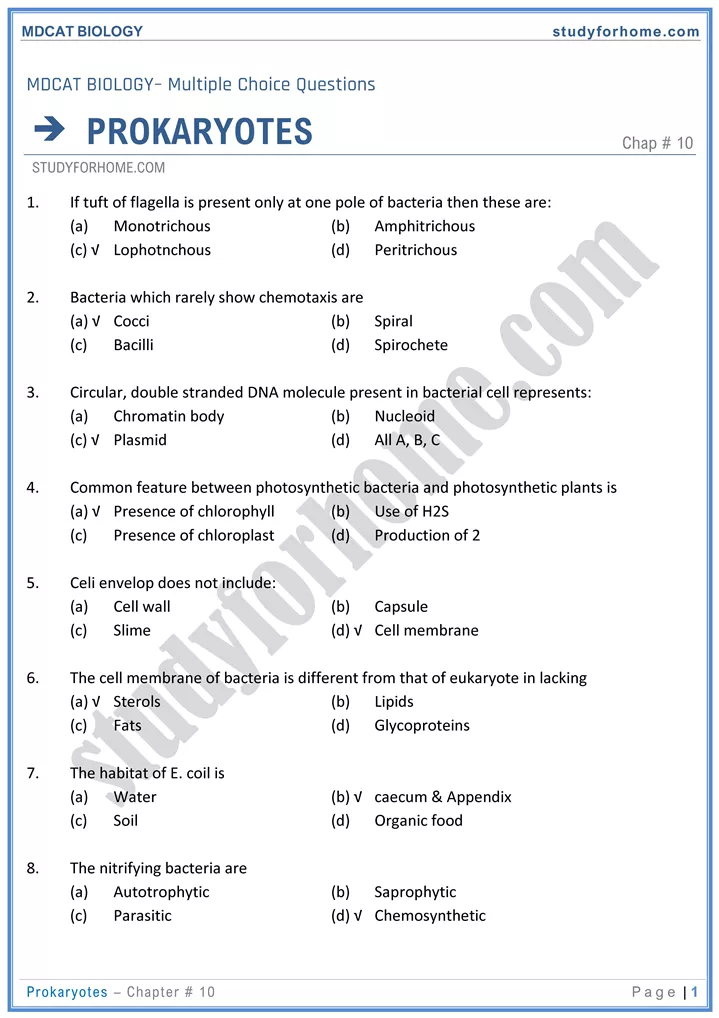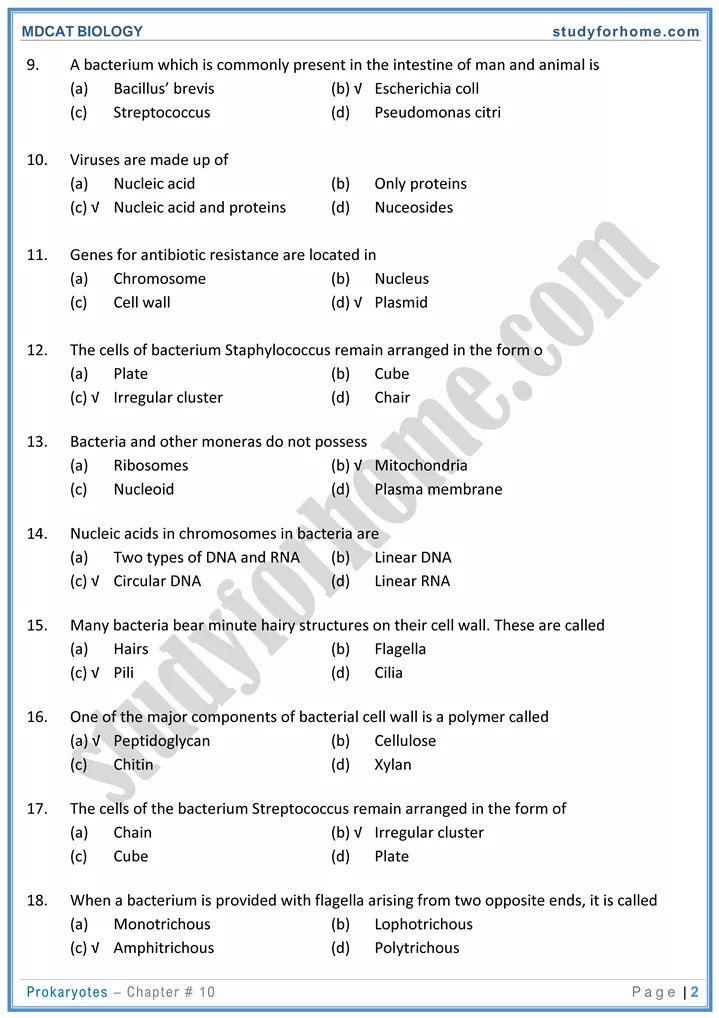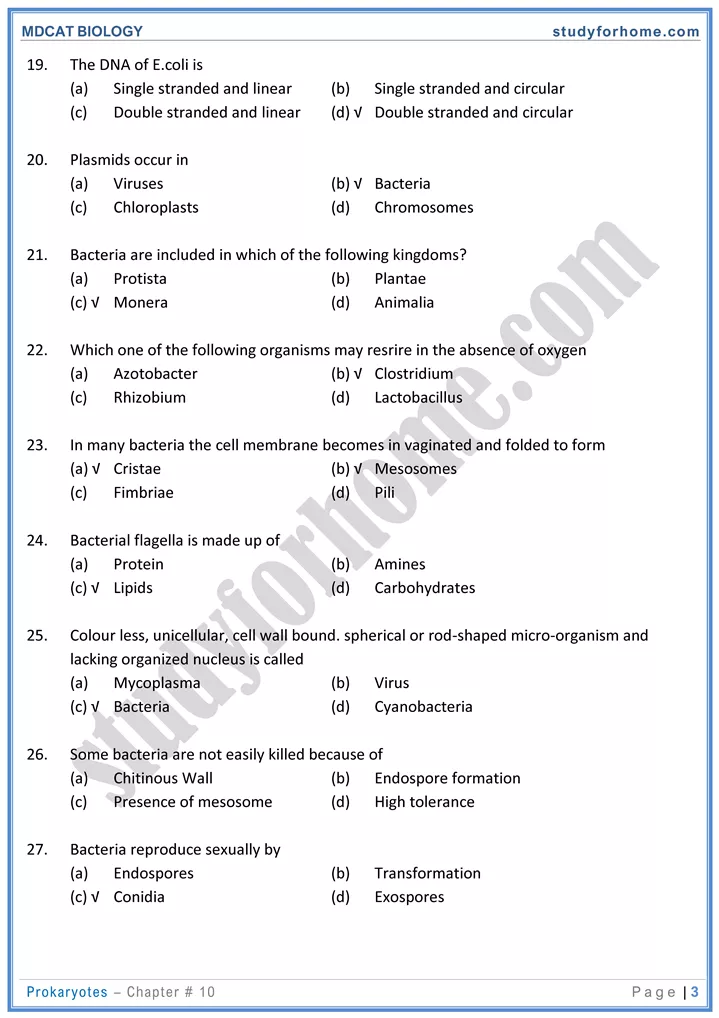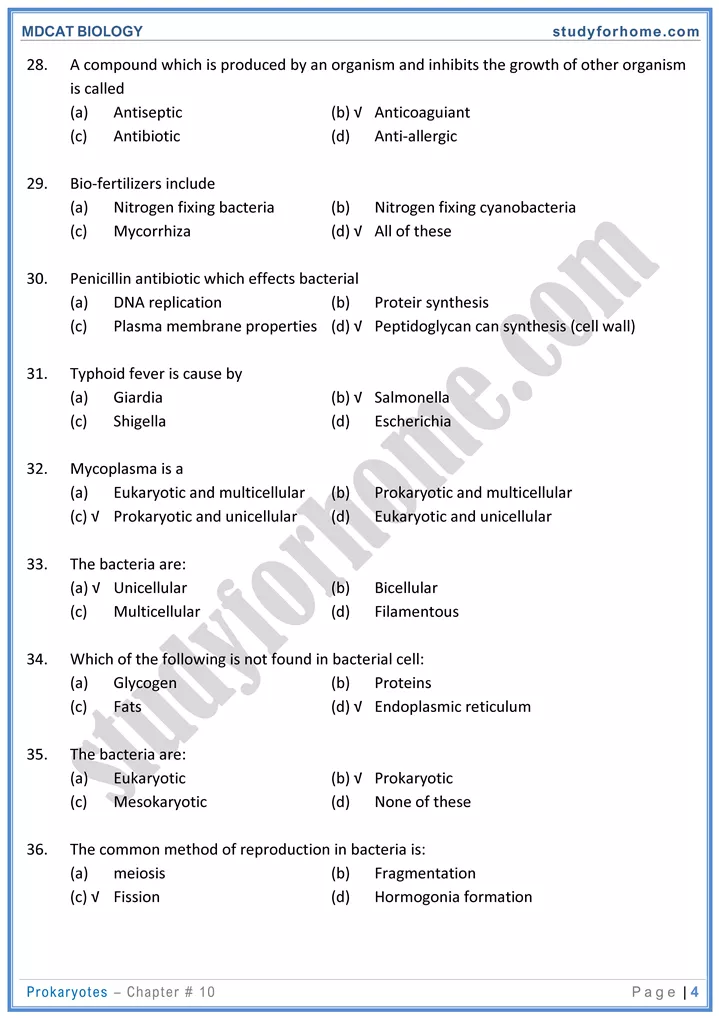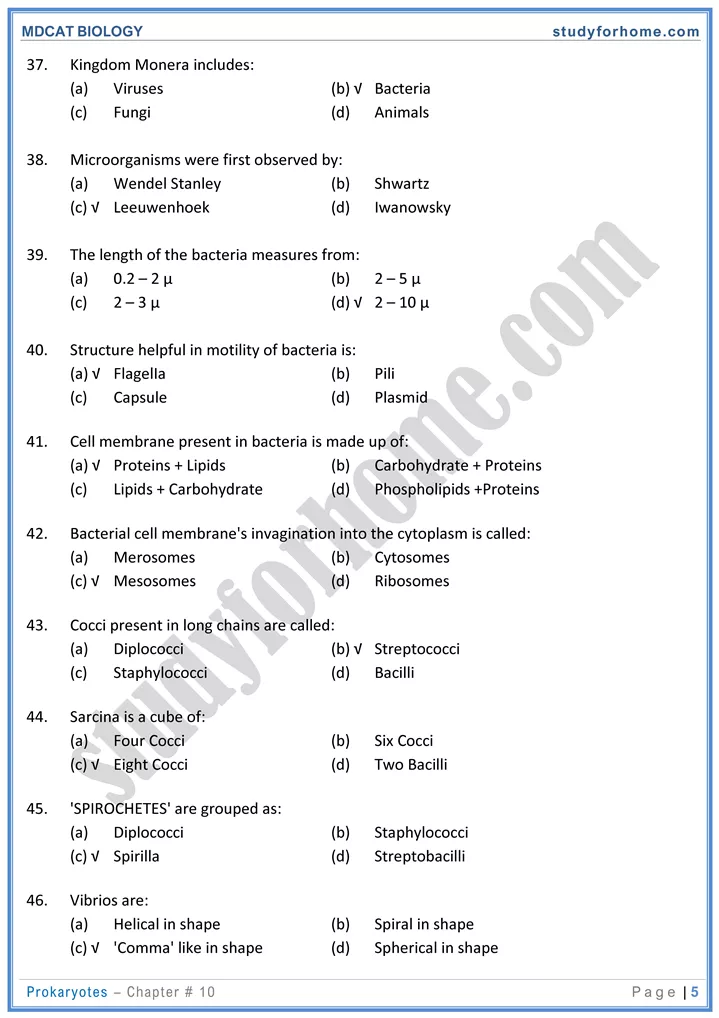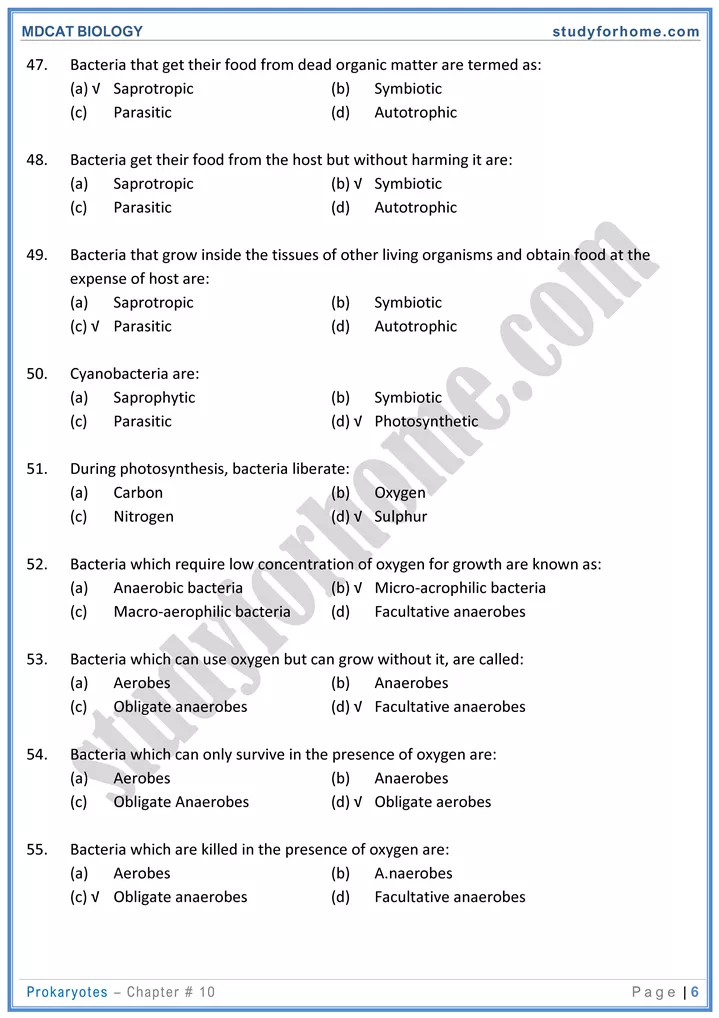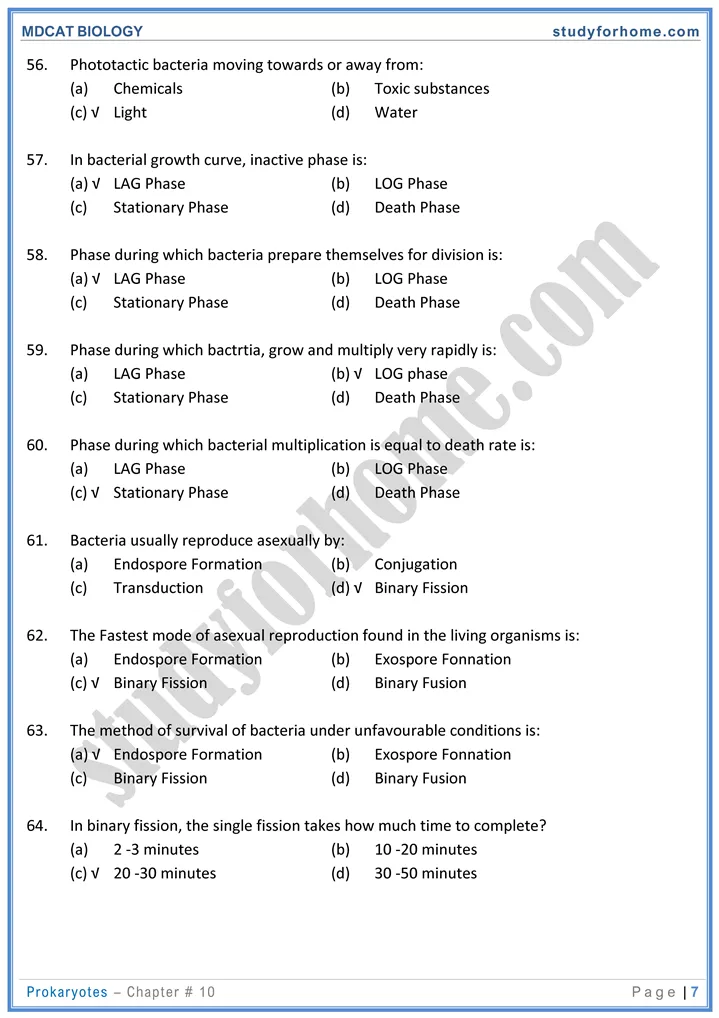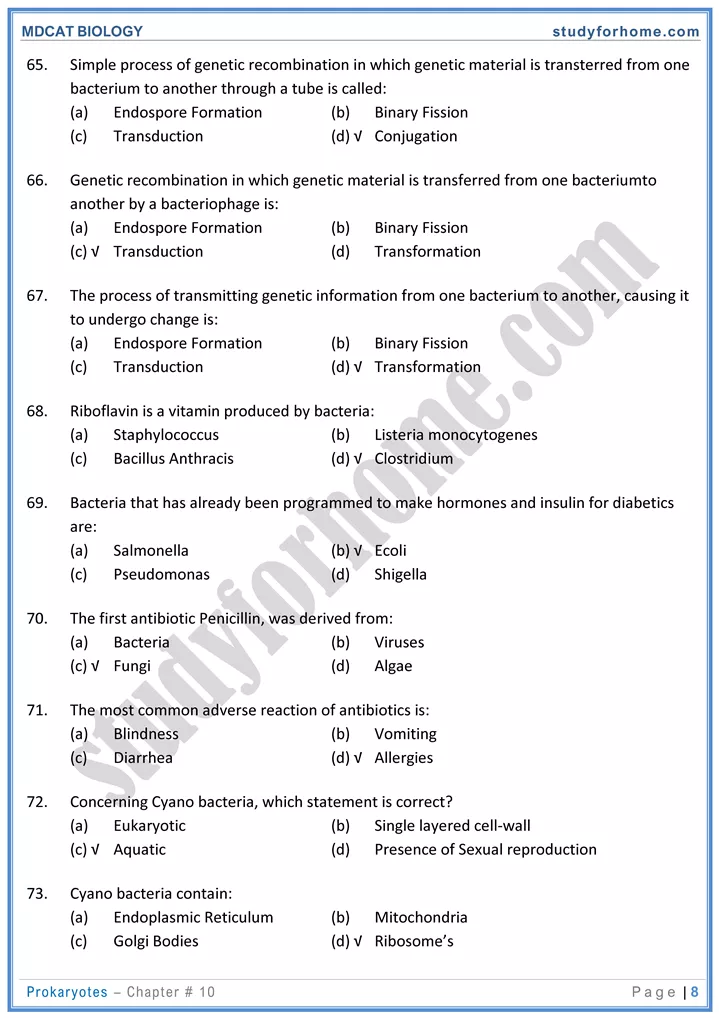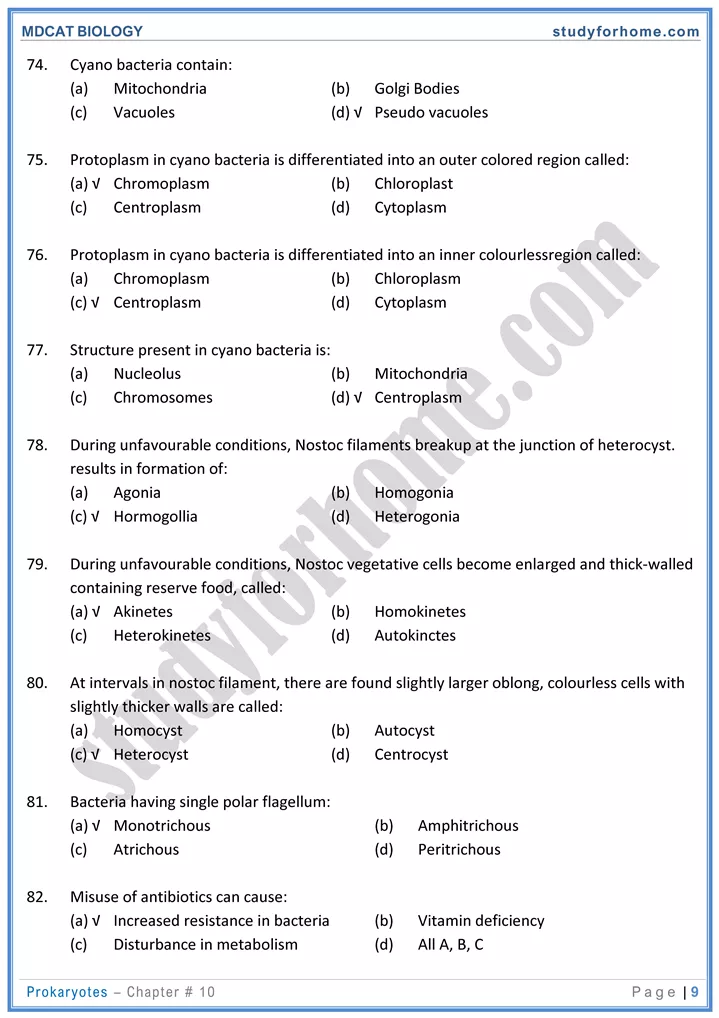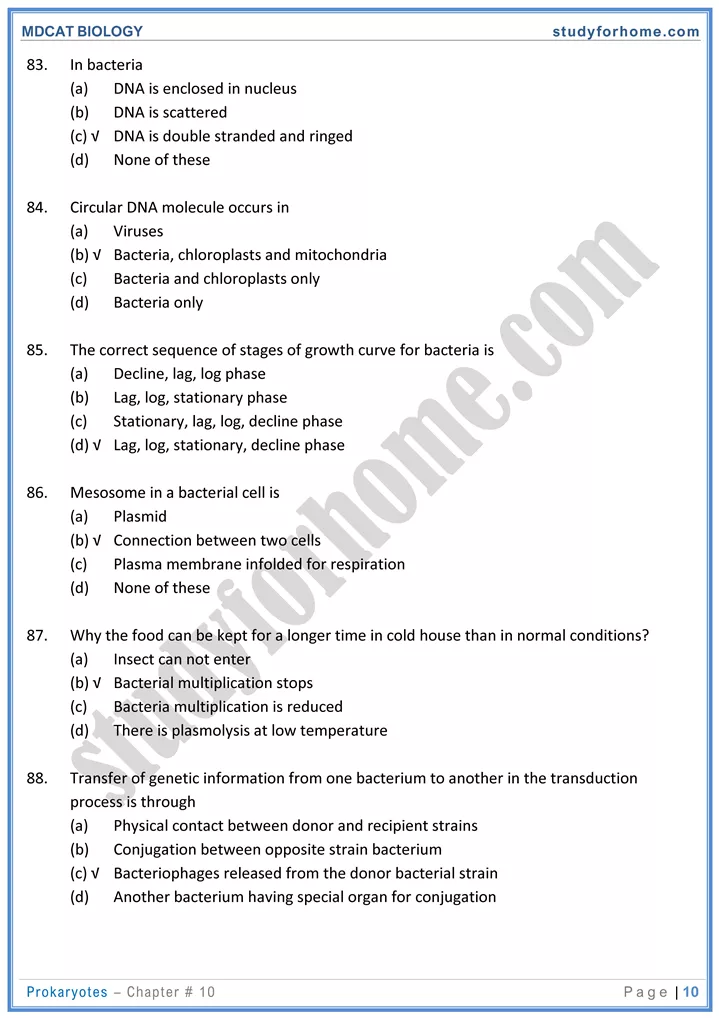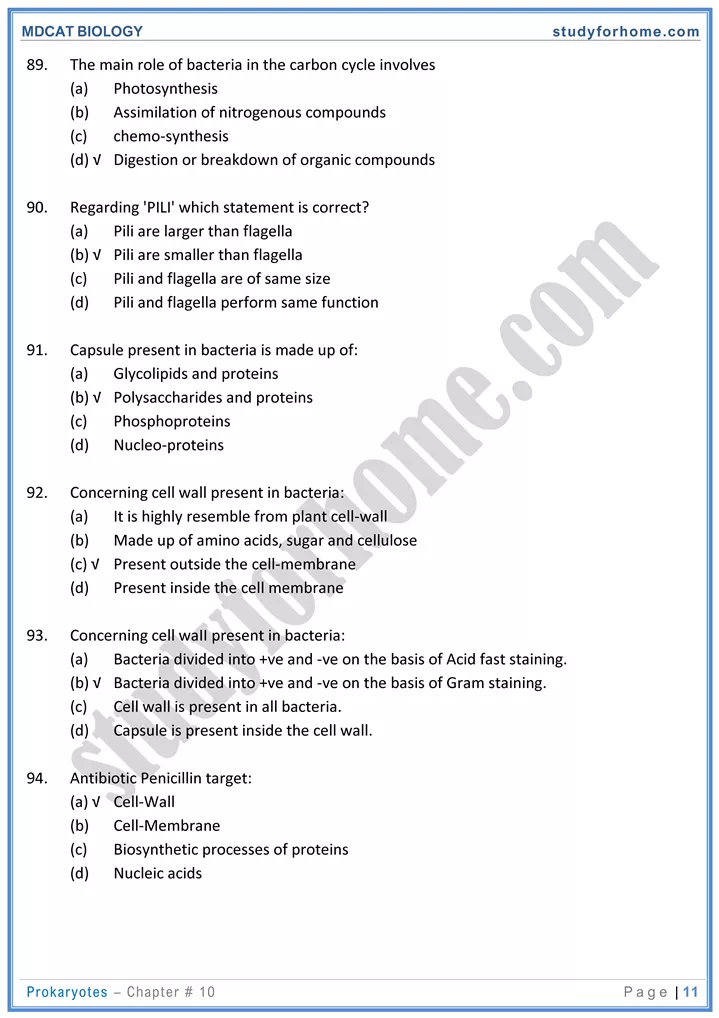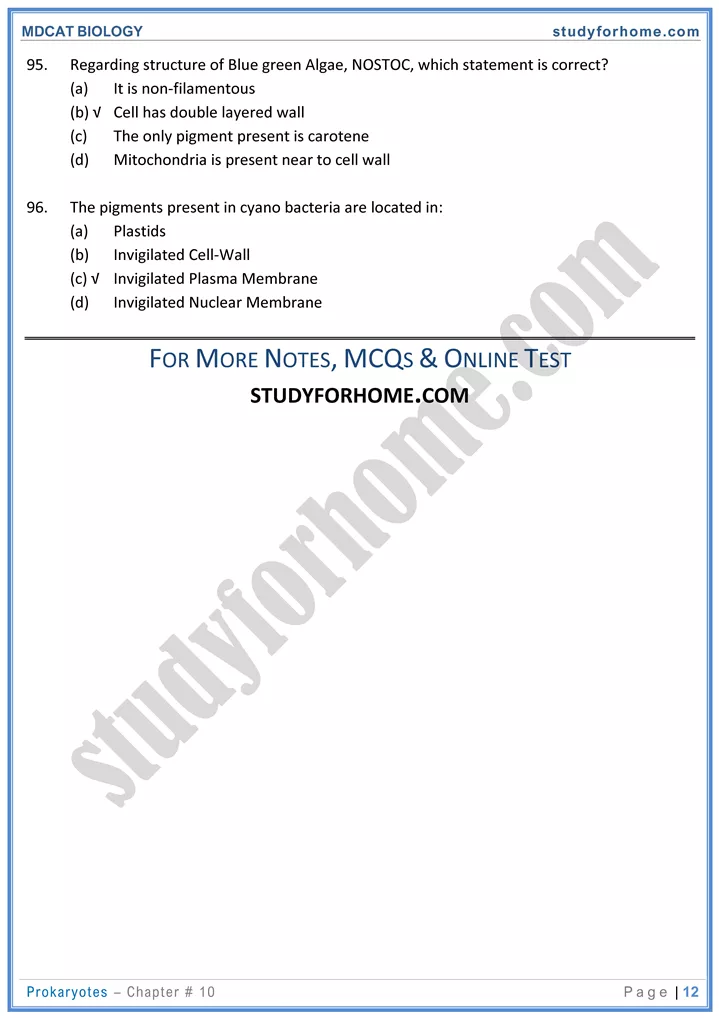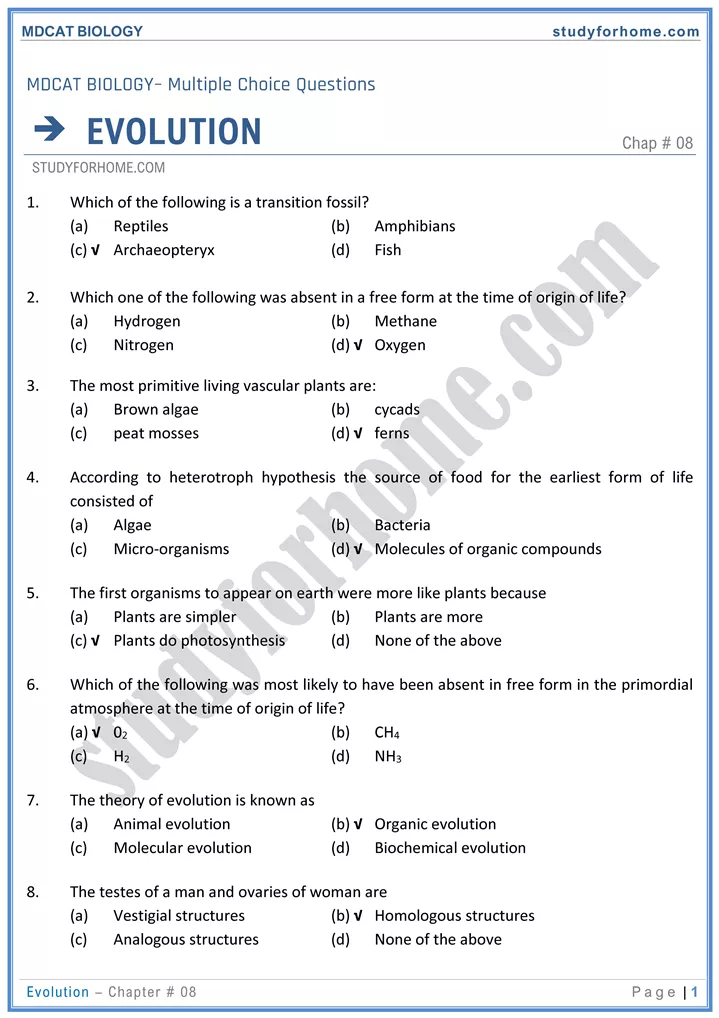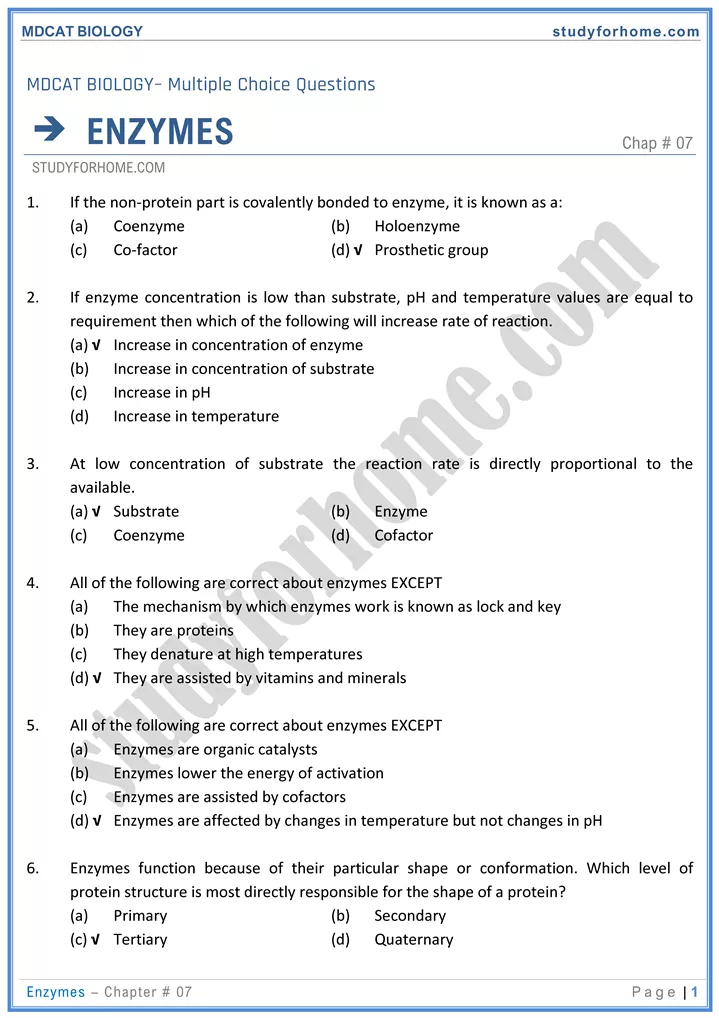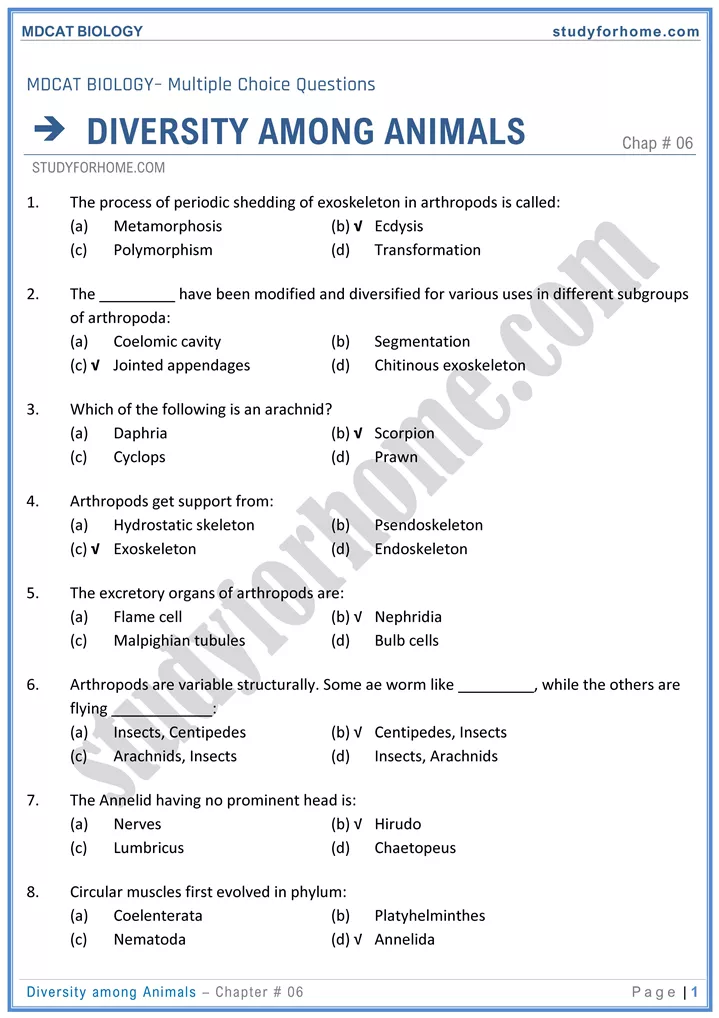Prokaryotes – Chap 10 – Biology MDCAT
-
Bacteria:
- Bacterial cell wall consists of macro molecule peptidoglycan (Murein) i.e. complex of amino acids and sugars.
- Mycoplasma is the smallest bacteria having no cell wall.
- Capsule is tightly bound to cell and aids in adhesion to surface in some bacteria.
- Slime is the loosely bound sheath surrounding cell in some bacteria. It is responsible for protection against phagocytosis of the host cells.
- Mesosomes are foldings of cell membrane and are associated with cell division, cellular respiration, DNA replication and transport of enzymes.
- Pill: appendages of bacterial cell. They are used for attachment and conjugation. They are not meant for locomotion.
- Cytoplasmic matrix contains ribosomes, granules, chromatin/nuclear body, nucleold and mesosomes.
- Protoplast: refers to plasma membrane and everything present in it.
- Bacteria can occur as unicellular entity or as colonies.
- Microaerophilic bacteria require low concentration of oxygen. E.g. campylobacter.
- Facultative bacteria grow either in presence or absence of oxygen. E.g. E.coli.
- Plasmid is extra chromosomal circular DNA.
- Cell wall of gram positive bacteria is stained purple whereas stained pink in gram negative bacteria.
- Archaebacteria are ancient bacteria lacking peptidoglycan in their cell wall.
- Eubacteria are true bacteria having peptidoglycan in their cell wall.
- High temperature, Gamma rays, membrane filters are physical methods for sterilization.
- Antiseptics are used on living tissues to inhibit growth of microorganisms.
- Phenols, H202 halogens, alcohol, formaldehyde, etc are used as disinfectants.
- Antibiotics inhibit growth / destroy microorganisms in living tissues such as sulfonamides, penicillin, tetracyclins.
- Antibiotics are synthesized by bacteria, actinomycetes and fungi.
- Spores and cysts are dormant vegetative cells that can grow in favorable conditions.
- Spores are heat resistant whereas cysts are not.
- Bacteria can be heterotrophic, saprotrophic, parasitic, autotrophic.
-
Genetics Recombination
- Garners are not formed sexually, bacteria is replicated by the division of DNA this type of reproduction is called genetics recombination, it is of three types.
-
- conjugation
- transduction
- transformation
-
Size and Shape of Bacteria
- Kingdom prokatyotae consists of organisms with prokaryotic cells. These organisms are simply called as bacteria which are microscopic, single-celled and thrive in diverse environments.
-
Size of Bacteria
- Bacterial cells are about one-tenth the size of eukaryotic cells. However, a few species are visible to the unaided eye.
|
Type |
Size |
| Range | 0.1-600 µm |
| Mycoplasma (Smallest) | 100-200 nm |
| Escherichia coli | 1.1-1.5 µm (width), 2.0-6.0 µm (length) |
| Spirochete | 500 µm in length |
| Staphylococci & Streptococci | 0.75-1.25 µm in diameter |
| Epulopiscium fishelsoni | 600 µm long, and 80 µm thick |
-
Shapes of Bacteria
- On the basis of general shape, bacteria are classified into three categories which may be Cocci (spherical or oval in shape), Bacilli (rod shaped) and Spiral (curved/ spring shaped).
- Most of the bacterial species have fairly constant characteristic cell shape. However, it has been shown that certain bacteria are capable of dramatically changing shape. Such bacteria are called as pleomorphic. For example, H. pylori exist in both a helix-shaped and a spherical form.
-
Bacterial Cell Structure:
- All bacterial cells invariably have a cell membrane, cytoplasm, ribosomes and chromatin bodies.
- The majority have cell wall, which gives shape to the bacterial cell.
- Specific structures like capsule, slime, flagella, pili, fimbriae and granules are not found in all bacteria.
-
Bacterial Appendages
- The structures that project from the surface of the bacterial cell are called bacterial appendages and include flagella, and pili fimbriae.
-
Cell Envelope
- The detailed studies of bacterial structure by the electron microscope revealed that the cell envelop is the outer wrapping of bacterial cell.
- Complexes of layers external to the cell protoplasm are collectively called cell envelope and commonly include capsule, slime and cell wall.
-
Capsule
- A thick, gummy structure giving sticky character to colonies of encapsulated bacteria.
- It is made up of polysaccharide units or proteins or both.
- It is tightly bound to the cell.
-
Slime
- Loose soluble shield of macromolecules outside capsule and can be removed from cell easily.
- Slime protects bacteria from environmental dangers such as antibiotics etc.
-
Cell Wall
- A rigid structure between extracellular substances and cytoplasmic membrane.
- Cell wall is only absent in Mycoplasma.
- It is composed of a macromolecule called peptidoglycan consisting of long glycan chains cross linked with peptide fragments.
- Sugar, teichoic acid, lipoproteins and lipopolysaccharides are also present which are linked with peptidoglycan.
- Teichoic acid fibers protrude outside the peptidoglycan.
- Cell wall of archaebacteria does not contain peptidoglycan; rather contain proteins, glycoproteins and polysaccharides.
- It determines the shape of bacteria and protects the cell from osmotic lysis.
- It provides identity to different bacteria, depending upon their staining characteristics. i.e., Gram positive and Gram-negative bacteria.
- The Gram-negative cell wall also contains a protein, the porins in outer membrane which act like pores for particular molecules.
-
Cell Membrane
- It is thin, flexible structure beneath the cell wall and completely surrounds the cytoplasm.
- It is very delicate in nature and any damage to it results in death of the organism.
- Bacterial membrane differs from eukaryotic membrane in lacking sterols such as cholesterol.
- It is involved in transport of proteins, nutrients, sugars and electrons or other metabolites.
- The plasma membrane of bacteria also contains enzymes for respiratory metabolism.
-
Cytoplasmic Matrix
- A gel-like substance present between the plasma membrane and the nucleoid.
- Plasma membrane and everything present within it is called protoplast.
- Cytoplasmic matrix lacks membrane bounded organelles and cytoskeleton; however, chromatin/ nuclear body, ribosomes, mesosomes, granules and nucleoid are present in it.
-
Nucleoid
- Other names for nucleoid are nuclear body, chromatin body and nuclear area.
- Nucleoid is the nuclear region of bacteria which is not separated from the cytoplasm by nuclear membrane. It consists of a single, large circular, double stranded DNA molecule, aggregates as an irregular shaped dense area in the centre of bacterial cell. Due to this single chromosome, bacteria are considered haploid organisms.
- A short duration of diploid state comes in their life cycle just before cell division when they replicate their DNA.
- It is visible in the light microscope after staining with Feulgen dye.
- The nucleoid DNA controls growth and metabolic activities of bacteria.
- coli closed circle chromosome measures approximately 1,4000 µm.
-
Plasmid:
- Circular, double stranded DNA molecules, self-replicating but not essential for the bacterial growth and metabolism.
- Contains genes of drug resistance, heavy metal resistance, disease, and insect resistance.
- Plasmids are important vectors in modern genetic engineering techniques.
-
Ribosomes:
- Smaller than eukaryotic ribosome.
- They are composed of RNA and proteins.
- May be loosely attached to the cell membrane or plasma membrane.
- They are involved in protein synthesis/translation.
-
Mesosomes:
- The cell membrane invaginates into the cytoplasm forming structure called as mesosomes. They occur in the form of vesicles, tubules or lamellae.
- They are involved in DNA replication, cell division, export of era-cellular enzymes.
- Respiratory enzymes are also present on the mesosomes.
-
Storage Bodies and Granules
- Since bacteria exist in a very competitive environment where nutrients are usually in short supply. They tend to store extra nutrients when possible.
- The nutrients may be useful e.g., glycogen, sulphur, fat and phosphate.
- In addition, cells contain waste materials that are subsequently excreted e.g., alcohol, lactic acid, and acetic acid.
-
Spores:
- These are metabolically dormant bodies, resistant to adverse physical environmental conditions such as light, high temperature, desiccation, pH and chemical agents.
- They may be exospores (external to vegetative cell) or endospores (inside vegetative cell/ inside cell wall).
- Endospores are more resistant structures and can survive for years.
- They germinate to form vegetative cell under favorable conditions. They normally develop at end stage of growth of bacteria.
-
Cysts:
- They are dormant, thick walled, desiccation resistant form but not heat resistant structures.
- They develop during differentiation of vegetative cells which can germinate under suitable conditions.
-
Importance of Bacteria:
- Bacteria are very important members of biodiversity from ecological, economical, biotechnological and research view point.
-
Ecological Importance of Bacteria:
- Ecological importance refers to the role of bacteria in environment, such as;
- Decomposition of dead/complex organic matter
- Humus formation to increase the fertility of soil
- Bioremediation etc.
-
Role of Bacteria as Recyclers:
- Bacteria serve as recyclers of nature as they are involved in decomposition of dead and complex organic matter in the environment.
- If the dead bodies are not decomposed, the organic nutrients present in their bodies would not be released in the environment. The organic carbon present in dead bodies might diminish all the CO2 from the atmosphere if there were no decomposers present on earth.
- Through this process, other organisms also get benefited, who can use the simple forms of organic compounds/nutrients released from the dead matter of various bacteria.
-
Role of Bacteria to Increase Soil Fertility by Humus Formation and N2-Fixation:
- The partially decaying organic matter of dead organisms is called humus. It contains nutrients and increases soil fertility for the growth of plants.
- It also increases the water retaining capacity of the soil. Bacteria and fungi are the only organisms that decompose dead animals and plants and thus, take part in humus formation.
- Soil is the only source of nitrogen for plants as they cannot inhale nitrogen directly from the atmosphere. Nitrogen from the atmosphere can be available to the plants through the process of nitrogen fixation.
- This process takes place with the help of nitrogen fixing bacteria like Rhizobium and Cynobacteria in the soil. These species of bacteria convert the atmospheric nitrogen into nitrates and nitrites as a part of their metabolism, and make it available to the plants.
- Leguminous plants have a mutualistic association with the bacteria living into their tissues for this purpose.
-
Role of Bacteria in Bioremediation:
- Removal or degradation of environmental pollutants by using living organisms is called bioremediation.
- It involves the use of many bacteria that either naturally loves to eat contaminants or have been genetically altered to give them the taste for toxins.
- Scientists are designing or deploying microbes to purge sites of contaminants such as Oil, radioactive waste, gasoline, mercury.
-
Economic Importance of Bacteria:
- The economic importance of bacteria refers to the role of bacteria in research and technology, plant diseases and in human diseases.
-
Role of Bacteria in Research and Technology:
- Bacteria play an important role in many technological fields, mainly in biological research, mining, medicine, production of food products, plastics synthesis and sewage treatment. The overall commercial worth of bacteria in these operations is immense.
-
Use in Genetics & Genetic Engineering:
- Bacteria have been used and being continuously used in the study of genetics and genetic engineering. Bacteria were used as model organism in number of famous experiments such as the discovery of DNA as heredity material, discovery of semi conservative replication of DNA and central dogma of life etc.
- Many components of bacterial cell are also being used as tool in genetic engineering experiments.
